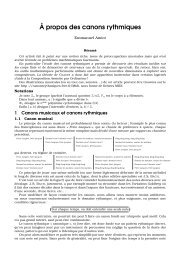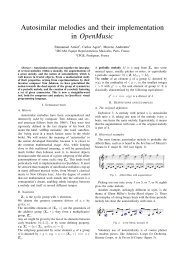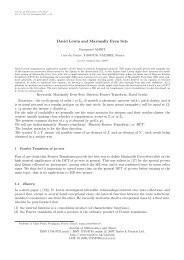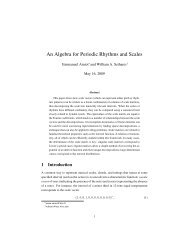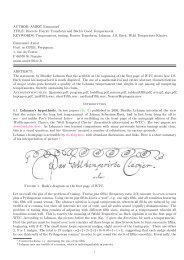Emmanuel Amiot Modèles algébriques et algorithmes pour la ...
Emmanuel Amiot Modèles algébriques et algorithmes pour la ...
Emmanuel Amiot Modèles algébriques et algorithmes pour la ...
You also want an ePaper? Increase the reach of your titles
YUMPU automatically turns print PDFs into web optimized ePapers that Google loves.
NEW PERSPECTIVES ON RHYTHMIC CANONS AND THE SPECTRAL CONJECTURE 3<br />
2.2. The revival. The connection b<strong>et</strong>ween Vuza’s work on RC and Hajós’ conjecture was drawn by Moreno Andreatta<br />
while working on his tesi di <strong>la</strong>urea [8] and then in his PhD [9] and in [7]. He focused some interest of the musical<br />
community on the ‘Rhythmic Canons of Maximal Categories’ (VC), and several musicians (especially composers) began<br />
to experiment with them, particu<strong>la</strong>rly with transformation b<strong>et</strong>ween rhythmic canons (RC). This allowed to understand<br />
that Vuza’s algorithm, while it produced VC for all ‘bad groups’ (non Hajós groups), i.e. all possible values of n, did<br />
not reach all possible VC. The point was discussed at least as early as 2003 at the MaMuTh me<strong>et</strong>ing in Zürich, or even<br />
previously: if, say A ⊕ B = Zn then by halving the tempo, and repeating motif A one beat after itself, one g<strong>et</strong>s a tiling<br />
of Z2n (read fig. 3 like a percussion score, each line standing for a different instrument p<strong>la</strong>ying at each b<strong>la</strong>ck square):<br />
or, more generally (see Prop. 4),<br />
A = 2A ∪ (2A + 1) and A ⊕ B = Zn ⇐⇒ A ⊕ 2B = Z2n<br />
A = kA ∪ (kA + 1) ∪ · · · ∪ (kA + k − 1) and A ⊕ B = Zn ⇐⇒ A ⊕ kB = Zk n<br />
Figure 3. Example of ‘stuttering’ starting with {0, 5, 10} ⊕ {0, 3, 6, 9} = Z10<br />
In word theory, this would mean applying the morphism 0 → 00, 1 → 11. More to the point, the new canon is also a VC<br />
whenever the old one was. So in that way we constructed VC that were not avai<strong>la</strong>ble with the algorithms provided by<br />
Vuza (or Hajós for that matter). There was a flurry of activity in 2003-2004 when we tried all kinds of transformations<br />
in order to produce previously unchartered Vuza Canons (cf. [2]). One productive way was to look for all complements<br />
of a tile already known to be a factor of a VC, and select the aperiodic ones. This en<strong>la</strong>rged the results provided by the<br />
Vuza algorithm. Moreover, by exhaustive production of RC in a given cyclic group, Harald Fripertinger ([13]) managed<br />
to find all VC for n = 72 and n = 108: as it happens, in the first case there are no others than the VC provided by Vuza’s<br />
algorithm; in the <strong>la</strong>tter, there are no others than the ones that we had found with our musical transformational techniques<br />
of previously known VC (more on this in section 2.4).<br />
Still the greatest breakthrough was arguably the seminal paper [11] in 1998, breaking new ground and introducing properly<br />
the s<strong>et</strong>s of cyclotomic indexes of a tile (like [19], I adapt slightly the original definition, aiming at tilings of Zn not Z: it<br />
is well known since the 50’s that any tiling of Z by trans<strong>la</strong>tions of a finite tile is periodic, hence it defines a tiling of some<br />
cyclic group. See for instance [4, 1, 12] for d<strong>et</strong>ails).<br />
Recall that the dth cyclotomic polynomial Φd ∈ Z[X] is an irreducible polynomial whose roots are the generators of the<br />
group of dth roots of unity. They can be computed recursively with the formu<strong>la</strong> <br />
Φd = X<br />
d|n<br />
n − 1. If we consider a tiling<br />
A ⊕ B = Zn, all cyclotomic polynomials with index d, 1 < d | n, must divide A(X) or B(X) (som<strong>et</strong>imes both).<br />
Definition 4. If A ⊂ Zn then the s<strong>et</strong>s RA = {d | n, Φd is a divisor of A(X)} and SA = {d ∈ RA, d is a prime power} are<br />
well-defined.<br />
In particu<strong>la</strong>r, changing A(x) by a multiple of x n − 1 does not change RA. For instance, motif A = {0, 1, 8, 9, 17, 28} gives<br />
A(x) = (1 + x) 1 − x + x 2 1 + x + x 2 1 − x 2 + x 4 1 − x 3 + x 6 1 + x 3 − x 4 − x 7 + x 8 − x 9 + x 11 − x 12 + x 13<br />
The first factors are Φ2, Φ6, Φ3, Φ12, Φ18; the <strong>la</strong>st one is not cyclotomic.<br />
The pertinence of RA can be understood from the following theorem, proved in [11]:<br />
Theorem 2. Consider two motifs A, A ′ with same cardinality.<br />
If A ⊕ B = Zn and RA = RA ′, then A′ tiles with the same outer rhythm: A ′ ⊕ B = Zn.<br />
This is very important in practice, as if we have a RC A ⊕ B = Zn then we can look for all others A ′ tiling with the same<br />
B. Note that in fact condition RA ⊂ RA ′ is sufficient for A′ to tile with B.<br />
Coven and Meyerowitz in [11] establish for the first time some conditions for a motif to tile:<br />
Definition 5.<br />
A ⊂ Zn satisfies (T1) if A(1) = <br />
p k ∈SA<br />
p, the product of the prime numbers p for each element p α of SA.<br />
A ⊂ Zn satisfies (T2) if for any powers of different primes p α , q β , r γ . . . in SA, their product p α × q β . . . lies in RA.<br />
They proved the following implications, the <strong>la</strong>st of which is difficult:




